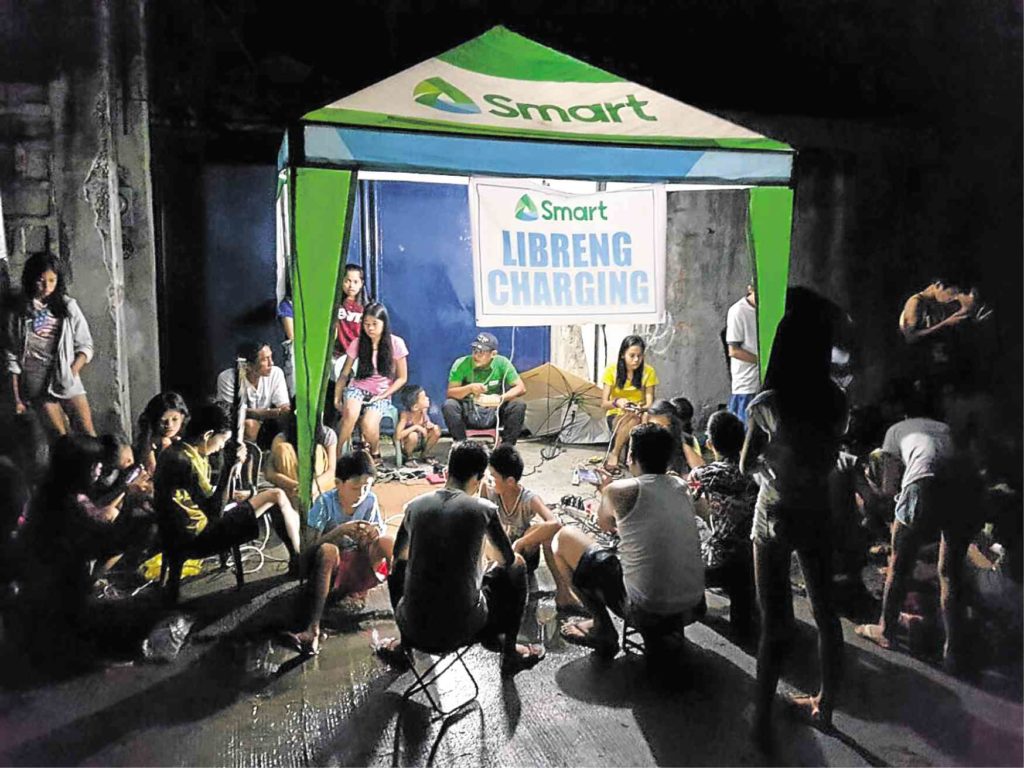Smart taps power of the youth

A Libreng Charging Station in Barangay Linao in Ormoc following the magnitude 6.5 earthquake that hit Leyte in July 2017.
Communication is aid.
Guided by this principle, local telco Smart Communications, Inc. has put disaster relief at the forefront of its corporate social responsibility efforts.
In light of recent calamities, the company has tapped a sector of society whom it feels can best help Filipinos be quicker on their feet should disaster strike—the youth.
Called the “TNT Tropang Ready Caravan,” Smart’s latest capacity-building CSR program enables university students to become experts at disaster preparedness.
The program is divided into two phases: First is a general assembly of participants—a crowd that could be as large as 3,000–in one of the 20 selected schools for a half-day training on basic disaster preparedness measures, such as what to put in a go bag and how to do a proper duck-cover-and-hold position.
“It’s not done via a lecture; it’s really via fun and games. It’s really about the day-to-day emergency [measures] like what you can use in your household for you to be ready. We also talk about the usual stuff like the go bag, e-balde (emergency pail), ensuring basic food security,” says Nova Concepcion, Smart’s community partnerships senior manager.
Smart also partners with the Philippine Institute of Volcanology and Seismology (Phivolcs), Philippine Atmospheric, Geophysical and Astronomical Service Administration (Pagasa), Project Noah (Nationwide Operational Assessment of Hazards), and local disaster risk reduction and management offices, which provide short, “bite-size” talks on weather- and disaster-related information.
After the initial half-day gathering, students who would like to pursue further training can attend the program’s second phase, or the “training of trainers.”
The workshop, which is held for a day with around 60 students, is more intensive, and is designed to equip the students with disaster preparedness and emergency skills.
The ultimate goal, says Concepcion, once the students have completed their training, is to have them share their knowledge and expertise on disaster preparedness with their respective communities.
“[Tropang Ready] morphed from a previous program called ‘Pamilya Ready, Pamilya Panalo,’ wherein we would go to vulnerable communities and do a half-day infotainment style of awareness generation [on disaster preparedness]. We learned that even if we spend 10 to 15 years of doing the rounds of vulnerable communities nationwide, it would not be as effective as partnering with an institution, or universities, which can easily duplicate the program,” explains Concepcion.
Students who participate in the training of trainers workshop are usually campus leaders, those taking their National Service Training Program (NSTP) classes, or members of the Reserve Officers’ Training Corps (ROTC), she adds.
The program has so far been rolled out in the following schools: Batangas State University, Bulacan State University, Southern Leyte State University, University of Science and Technology of Southern Philippines–Cagayan de Oro, University of Baguio, Isabela State University, Eastern Visayas State University, and St. Peter’s College-Ormoc. Of these, it is Batangas State University’s students which have gone out to communities to cascade what they’ve learned.
Smart plans to implement the program in more universities until it reaches its goal of 20 partner institutions in the next three years, says Concepcion.
Its most important CSR program, however, she adds, is Smart’s cellular service itself.
“When you have communication you lessen the confusion: When you need help, you can easily get it, and those giving aid will also know what exactly you need. That’s why we have free calls and texts during disasters—it’s in our DNA,” says Concepcion. “Ten years ago it wasn’t like this, but times have changed. Now, the day after a calamity hits, people seek out any means of cellular communication. That’s why communication is aid.”















